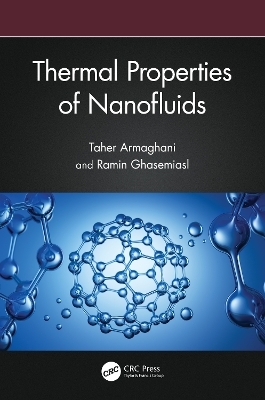
Thermal Properties of Nanofluids
CRC Press (Verlag)
978-1-032-66406-4 (ISBN)
Thermal Properties of Nanofluids presents emerging prospects for understanding and controlling thermophysical properties at the nanoscale. It covers a comprehensive study of recent progress concerning these properties from the solid state to colloids and, above all, a different look at the effect of temperature on nanofluids’ thermal conducting.
Introducing various techniques for measuring solid-state properties, including thermal conductivity, thermal diffusivity, and specific heat capacity, this book presents modeling approaches developed for predicting these properties by molecular dynamic (MD) simulations. It discusses the main factors that affect solid-state properties, such as grain size, grain boundaries, surface interactions, doping, and temperature, and the effects of all these factors.
This book will interest industry professionals and academic researchers studying the thermophysical behavior of nanomaterials and heat transfer applications of nanofluids. It will serve graduate engineering students studying advanced fluid mechanics, heat transfer, and nanomaterials.
Taher Armaghani is an Associate Professor of Mechanical Engineering at the West Tehran Branch of Islamic Azad University. He earned his BSc, MSc, and Ph.D. in Mechanical Engineering from Shahrood University of Technology, Shahrood, Iran. He teaches advanced heat transfer in the nanoscience field in Ph.D. grade. He has published more than 60 ISI in the nanoscience field. He has published two books in the nanoscience field about applications of nanofluids and nanofluid applications in microelectronics. He is also an editor of the Journal of Nanofluid and a guest editor on special topics of nanofluids in some journals. Additionally, he serves as a reviewer of more than 100 scientific journals in nanoscience field. In current studies, the modern experimental heat transfer of nanofluids will be explored in the advanced heat transfer laboratory of the West Tehran branch of Islamic Azad University instituted by Dr. Taher Armaghani and Dr. Ramin Ghasemiasl. Ramin Ghasemiasl has been an Assistant Professor of Mechanical Engineering at the West Tehran Branch of Islamic Azad University since 2010. He earned his Ph.D. in Mechanical Engineering from Tarbiat Modares University (TMU), Tehran, Iran. He has published more than 40 WOS papers, more than 50 papers in conferences, and 12 books. His research interest includes renewable energy, the multi-generation system for product electricity, freshwater and hydrogen, and nanofluids applications in modern technologies. In current studies, the modern experimental heat transfer of nanofluids will be explored in the advanced heat transfer laboratory of the West Tehran branch of Islamic Azad University instituted by Dr. Ramin Ghasemiasl and Dr. Taher Armaghani.
1. Introduction. 2. Solid State. 3. Colloidal Nanofluids Thermal Conductivity. 4. New Look at Nanofluid Thermal Conductivity Correlations. 5. Viscosity. 6. Statistical Study and Overview of Nanofluid Viscosity Correlations. 7. Other Thermal Properties of Nanofluids. 8. Selecting a Thermophysical Model for Numerical Modeling of Nanofluids.
| Erscheinungsdatum | 18.10.2024 |
|---|---|
| Zusatzinfo | 26 Tables, black and white; 110 Line drawings, black and white; 13 Halftones, black and white; 123 Illustrations, black and white |
| Verlagsort | London |
| Sprache | englisch |
| Maße | 156 x 234 mm |
| Gewicht | 771 g |
| Themenwelt | Technik ► Elektrotechnik / Energietechnik |
| Technik ► Maschinenbau | |
| Technik ► Umwelttechnik / Biotechnologie | |
| ISBN-10 | 1-032-66406-1 / 1032664061 |
| ISBN-13 | 978-1-032-66406-4 / 9781032664064 |
| Zustand | Neuware |
| Haben Sie eine Frage zum Produkt? |
aus dem Bereich


